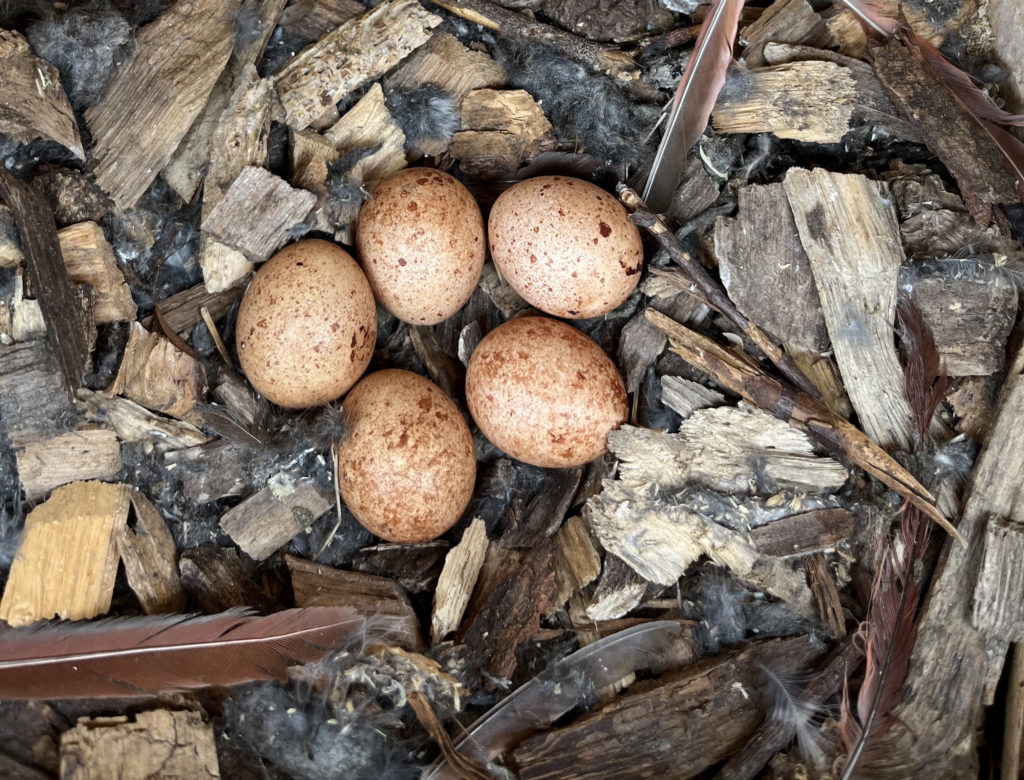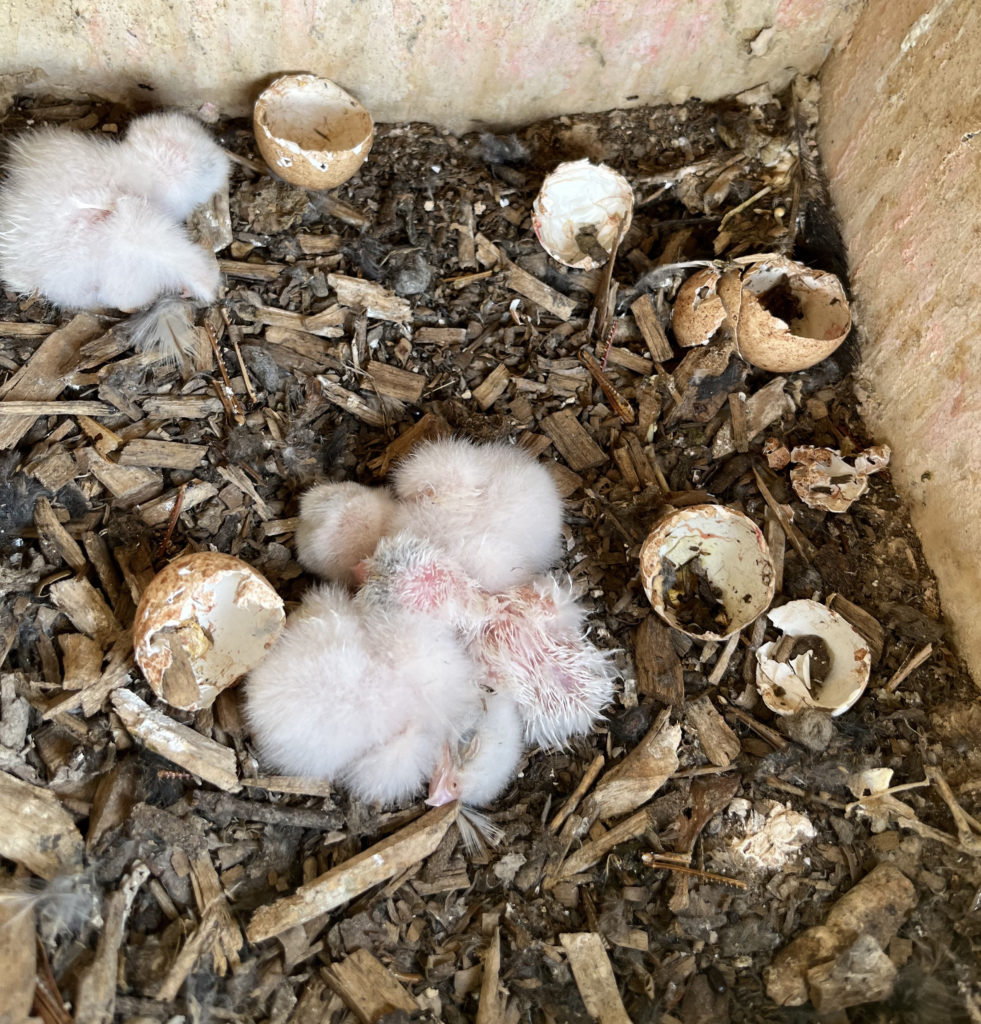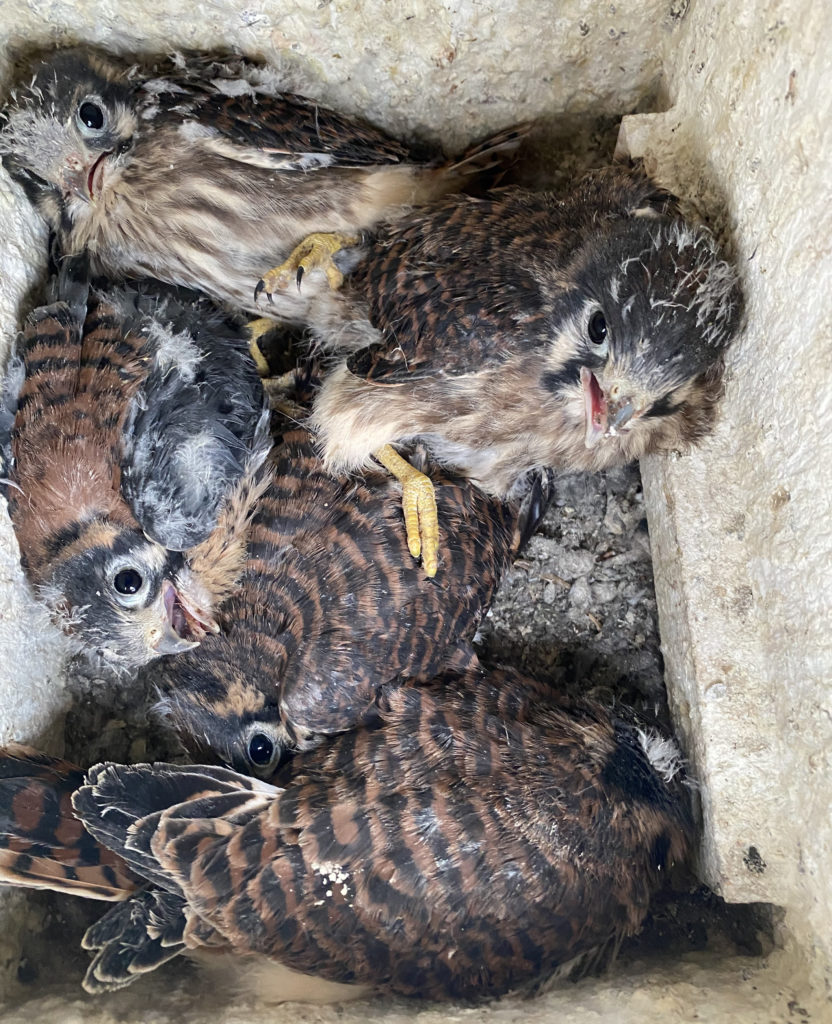For American Kestrels, It Pays To Stay In Sync With Spring
May 24, 2022By Robyn Bailey, NestWatch Project Leader

A Typical Clutch
In American Kestrels, one egg is typically laid every other day. They will be incubated for approximately 27-30 days before hatching.
As we learned in last month’s blog post, birds have evolved so that their nesting season coincides with the peak abundance of food on their breeding grounds. For most North American species, that’s springtime. Climate change is causing some species to breed earlier in response to earlier peaks in food resources. While many studies have focused on birds that eat insects, what do birds with other types of diets do when spring arrives earlier than anticipated? American Kestrels are small falcons that don’t rely on one specific type of food; they eat insects, small mammals, birds, and lizards. They also have a longer incubation and nestling period than a small songbird, so they need resources to be more stable, longer.
To study the effects of earlier spring conditions on American Kestrel nesting success, the authors of a recent study combined records from two nationwide citizen science databases (the Cornell Lab of Ornithology’s NestWatch program and The Peregrine Fund’s American Kestrel Partnership program) with data from a professional multi-state study conducted on Department of Defense lands and a long-term study from Southwestern Idaho (Callery et al. 2022). This produced a dataset of 2,144 nests spanning nearly 25 years from around the contiguous United States and southern Canada.
How To Measure Spring When Spring Keeps Changing?
If you’ve lived in a very seasonal environment, you may have observed that “spring” arrives earlier or later in different years depending on when warmer weather starts becoming more consistent. Warmer weather and longer days, in turn, trigger things like bird migration, leaf out, and insect emergence. So, phenological “first day of spring” is more relevant to birds than the actual calendar date. In order to see things from a kestrel’s perspective, the researchers used an index of spring conditions (based on flowering plants and surface temperatures) as an indicator of when spring started in a given year (i.e., as opposed to using the calendar date). Then, they calculated the difference between this index and when kestrels started laying eggs. They found that kestrels start laying eggs 12 days (median) before phenological spring’s onset (Callery et al. 2022).

Just Hatched
These recently hatched American Kestrels will need 28–31 days to grow up and leave the nest cavity.
The Early Bird Advantage
According to this new study, American Kestrels that delayed egg laying until after spring had sprung were more likely to have failed nests, and this was particularly true for kestrels in the highly-seasonal environment of the Northeast. Conversely, when nesting earlier than the onset of spring, kestrels in the Northeast had an advantage; they produced more young per brood than kestrels in the West, Southwest, and Southeast with similar timing. Rangewide, the more out-of-sync they got with the onset of spring, the fewer young they could fledge, which was again most pronounced in the Northeast. This problem of spring mismatch was not as bad for kestrels in the Southwest (e.g., a nest begun 30 days outside of the peak could still fledge 4 young), indicating that southwestern kestrels might be more resilient to spring’s fluctuations.
Nest Cams Reveal a Possible Adaptation
Interestingly, kestrels may be able to perceive the disadvantage of delayed nesting and adjust for it by changing their incubation behavior. A subset of the boxes were monitored with nest cams which revealed that “late-starting” males would begin incubating sooner, joining with the female to incubate almost continuously. This behavior speeds up egg development so that the eggs hatch asynchronously (i.e., on different days). With this strategy, there would be some older and some younger siblings within the brood. Spreading out the nestlings’ hatch dates could give the kestrels the opportunity to spread out the risk of starvation—that is, they would have at least some nestlings which were more mature and might survive if conditions were poor. The males have been previously shown to employ this strategy in poor food years, suggesting it helps reduce the amount of provisioning required per day. Males at “early” nests did not join in the incubation process as quickly, making it more likely that their young would be closer together in age and increasing the potential for more young to fledge.
The Narrow Window of Opportunity

Full House
Five American Kestrel nestlings are nearly ready to fledge.
In summary, waiting until after phenological spring’s arrival to start nesting was a disadvantage for kestrels, particularly those in the Northeast. “Late” nesters had decreased nest success overall and those that did succeed produced fewer fledglings. If you are a kestrel living in the Northeast, it pays to be on time. Why do Northeastern kestrels need to be especially timely? The authors hypothesized that the Northeast does not have the prolonged growing season that other regions may have, which could give other kestrels more flexibility in when they decide to breed. Milder winters, earlier plant bloom dates, and longer growing seasons mean that kestrels in the West and Southwest have about a 4-month window in which to initiate their clutches while those in the Northeast have only about a 2-month window (after which productivity declines sharply). This is consequential for a bird whose incubation and brooding period can take around two months, not to mention post-fledging care.
American Kestrels are in a long-term population decline across much of North America, and evidence suggests that climate change will affect them (McClure et al. 2017), regardless of their generalist diet. Can they make up some losses by changing their behavior? Researchers aren’t sure yet if the “speed it up” behavioral change actually results in fledglings that survive well after they leave the nest. One thing the public can do to help out is to continue reporting on kestrel nest success as contributors to citizen science; we know that without you all, this study would not have been possible!
References:
- Callery, K., S. E. Schulwitz, A. R. Hunt, J. M. Winiarski, C. J. W. McClure, R. A. Fischer, and J. A. Heath. 2022. Phenology effects on productivity and hatching-asynchrony of American kestrels (Falco sparverius) across a continent. Global Ecology and Conservation 36: e02124. https://doi.org/10.1016/j.gecco.2022.e02124
- McClure, C. J. W., S. E. Schulwitz, R. Van Buskirk, B. P. Pauli, and J. A. Heath. 2017. Commentary: Research recommendations for understanding the decline of American Kestrels (Falco sparverius) across much of North America. Journal of Raptor Research 51(4): 455-464. https://doi.org/10.3356/JRR-16-73.1

One comment on “For American Kestrels, It Pays To Stay In Sync With Spring”
I’ve lived in Northern CA all my 74 years. Kestrels used to be everywhere. They are now very rare in Alameda County. I have only seen one Male in El Dorado County where I moved recently. That was during April.
Depuis 20 ans j’ai un sentier de crécerelles ,avant c’était mon cousin qui avait fait un suivit de plus de 50 année .L’année dernière c’est 58 petits qui sont nés J’ai fais une émission à la semaine verte de Radio Canada sur le sujet plus 11 émission que vous pouvez trouver sur youtube sous le titre de Rolland avec deux ailles
I never thought about it that way before.